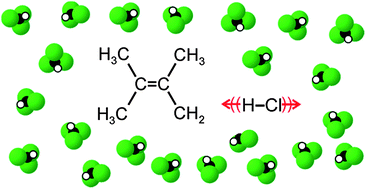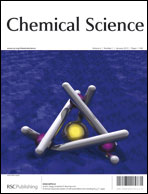Broadband transient infra-red absorption measurements are reported that contrast the dynamics of reaction of Cl atoms with 2,3-dimethylbut-2-ene and n-pentane in chlorinated solvents. In both cases, H-atom transfer produces HCl and a hydrocarbon radical, but the energy release in the former reaction is greater because of the formation of a resonance-stabilized allylic radical. The reaction of Cl atoms with n-pentane in solution in CH2Cl2 forms HCl exclusively in its lowest vibrational level (v = 0), and our measured rate coefficient agrees with a prior report by Sheps et al., J. Phys. Chem. A, 2006, 110, 3087. The time-dependence of the growth of intensity in the HCl fundamental absorption band shows two domains of reaction: a prompt rise is associated with reaction of the photolytically generated Cl atoms with n-pentane molecules lying within the first solvent shell, whereas a slower further rise is attributed to reaction following diffusion through the solution. For the reaction of Cl atoms with 2,3-dimethylbut-2-ene, these two domains of reaction are also observed, and fitting to a kinetic model incorporating these components gives bimolecular rate coefficients for formation of HCl of (1.7 ± 1.4) × 1010 M−1 s−1 in CDCl3 and (3.4 ± 1.2) × 1010 M−1 s−1 in CCl4. However, an additional transient absorption is observed ∼115 cm−1 lower in wavenumber than the fundamental HCl absorption band and is assigned to the v = 2 ← v = 1 hot band of HCl. The absorption by the nascent HCl(v = 1) peaks after ∼20 ps and subsequently decays to baseline levels because of vibrational relaxation, which is shown to be enhanced by energy transfer to 2,3-dimethylbut-2-ene. In solution in CDCl3, the fraction of HCl formed initially in v = 1 is determined to be 0.24 ± 0.04 and in CCl4 it is 0.15 ± 0.02. The branching to HCl(v = 1) for these reactions in solution is significantly lower than the 0.48 ± 0.06 fraction reported for reaction of Cl atoms with propene in the gas phase [Pilgrim and Taatjes, J. Phys. Chem. A, 1997, 101, 5776]. This comparison between similar bimolecular reactions in solution and in the gas phase therefore identifies changes to the dynamics caused by interaction with the solvent. Solvent friction experienced by the separating products of the reaction is considered more likely to be responsible for the lower vibrational excitation of the nascent HCl than is solvent modification of the topology of the potential energy surface in the vicinity of the transition state. Possible consequences of addition of Cl to the unsaturated bond in 2,3-dimethylbut-2-ene are also discussed.


 Please wait while we load your content...
Please wait while we load your content...